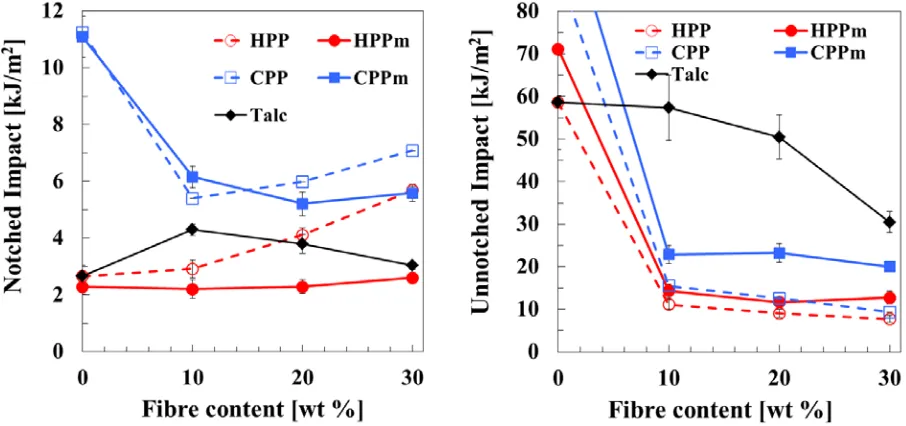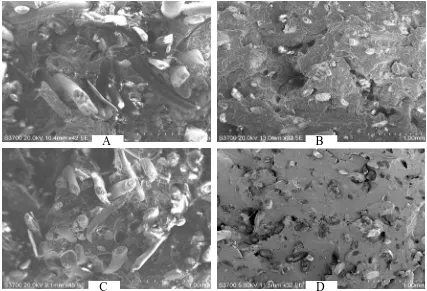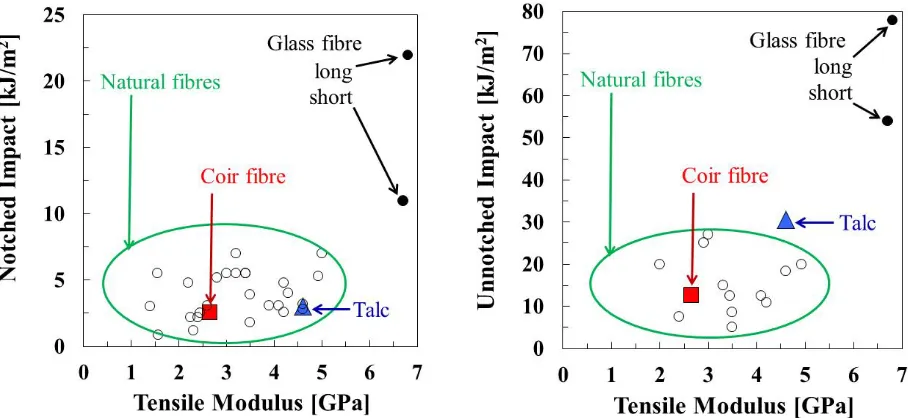11th Canadian-International Conference on Composites
Evaluation of Injection Molded Natural Fiber-Polypropylenes for
Potential in Automotive Applications
J Thomason
1*, J Rudeiros-Fernández
21,2
Department of Mechanical and Aerospace Engineering, University of Strathclyde, Glasgow,
United Kingdom
* Corresponding author (
james.thomason@strath.ac.uk)
ABSTRACT
This paper presents results from measurements of the interfacial adhesion of coir fiber with various polypropylene matrices along with the mechanical properties of their related injection molded composites. Fiber-matrix adhesion, including the effect of polymeric coupling agent, was characterized using the fiber pull-out method. The addition of coupling agent significantly increased the interfacial shear strength of coir fiber-polypropylene. Results from tensile and impact testing of coir reinforced polypropylene composites showed that the coupling agent increased composite tensile strength and unnotched impact strength but reduced notched impact performance. The potential of these materials to replace existing automotive materials is discussed. It is concluded that coir reinforced-polypropylene is not a suitable candidate to replace glass fiber - polypropylene but that it may have some potential as a replacement in lower performance talc reinforced polypropylene applications.
KEYWORDS: Natural fiber, Polypropylene, Adhesion, Impact
1 INTRODUCTION
Understanding the mechanical behaviour of NF and the influence of fiber-matrix adhesion is essential to successfully improve the mechanical performance of natural fiber reinforced thermoplastic compounds. This paper presents a study of single fiber pull-out measurements of the interfacial shear strength (IFSS) of coir fiber with various polypropylene (PP) matrices along with the mechanical properties of their injection molded composites. Result from tensile and impact testing for characterisation of composite modulus, strength and impact strength are presented. The influence of adhesion on the performance of injection molded composites is discussed.
2 EXPERIMENTAL
The coir fiber and polymers used for this study were provided by SABIC. Coir fibers were used as delivered for pull-out testing. The matrices used for composites and pull-out testing were homopolymer PP 579S and copolymer PP 513MNK10. Maleic anhydride grafted polypropylene Exxelor PO 1020 (MaPP) was used as coupling agent. The effect of MaPP on the interfacial properties of coir-PP samples was investigated for 0, 3, 5, 10 wt% MaPP content.
The interfacial shear strength (IFSS) of coir fiber and PP was characterised using the single fiber pull-out technique. All the fibers were individually separated until no fraying could be seen with the naked eye. Pull-out samples were prepared in an in-house built mold, which allowed the fibers to be aligned perpendicular to the surface of the mold where the polymer pellets were placed. The mold was designed to produce a cylinder-shaped matrix with a fiber embedded along the axis of the cylinder. In order to reduce the thermo-oxidative degradation of PP and coir fibers, samples were prepared in a nitrogen atmosphere. Once the fibers and the polymer were placed on the rig, the assembly was covered with a metallic chamber connected to a nitrogen cylinder. The nitrogen flow was established at 200 ml/min (1.5 bar). The temperature of the mold was monitored by a thermocouple connected to the chamber. The whole system was then placed on a hot plate at 230 °C for 18 minutes. Subsequently, the rig-mold was taken off the hot plate, the chamber was opened and the samples were left to cool down at room temperature. Pull-out testing was carried out using an Instron 3342 tensile testing machine with a 100 N load cell. Crosshead extension rate was established at 0.5 mm/min. The pull-out samples were fixed by an in-house built device and the fiber was clamped at a gauge length of approximately 5 mm.
Natural fiber cross section area (CSA) is non-circular and non-constant along the fiber length Thomason et al., 2011). In this study, as an initial approximation, the CSA of coir fibers was assumed to be circular.For each sample, the fiber diameter (D) and embedded length (Le) was characterised after the sample was tested. The embedded length was measured on the polymer cylinder using a calliper. Fibers embedded area was transversally photographed using an Olympus GX51 microscope. Fiber diameter was measured at three different points using software ImageJ. Fiber average diameter was based on these three measurements. The peak load (Fmax) from the load-displacement curve was combined with D and Le to calculate the apparent IFSS (τ) using equation 1. A minimum of 18 samples, with different fiber diameters and embedded lengths, were tested for each system. In this paper average IFSS values are presented with their 95 % confidence limits. Samples that failed during testing were further investigated using a Field Emission Scanning Electron Microscope (FE-SEM) HITACHI SU-6600.
e max
DL
F
π
τ
=
(1)injection molded into standard test specimens using an LT Demag 100 ton injection molding machine. Barrel zones were electrically heated and were maintained between 180-200°C and the screw speed was 80 rpm. The mold was maintained at ambient temperature. Tensile testing of composites was carried out according to ISO 527-2/1A/1 using an Instron 5969 with a 50 KN load cell. Notched and unnotched Charpy impact strengths were measured at room temperature according to ISO 179-1:2010 with edgewise impact using a Tinius Olsen Model Impact 503. Notched samples were manufactured based on ISO 179-1/1eAb. All average results are illustrated with 95% confidence limit error bars. Composite fracture surfaces were examined using a HITACHI S-3700 Scanning Electron Microscope.
3 RESULTS AND DISCUSSION
3.1 Interfacial Strength by Pull-out Testing
Figure 1 illustrates values of peak load obtained from the load-displacement curves from pull out testing and the embedded area of coir fiber in HPP. Results showed a good linear correlation between the two variables. The IFSS for the system can be obtained from the slope of the fitted straight line or from the average of individual values calculated using Equation 1. Figure 1 also shows the average IFSS values for HPP and CPP systems with different MaPP contents. Addition of MaPP generally led to an increase in the measured IFSS. For HPP there was no significant increase in IFSS until at least 5% wt MaPP was added and there was little observed increase in IFSS at the 10% levels of MaPP. Nevertheless, there was a further increase in IFSS when 100% MaPP was used as the matrix. For the CPP polymer the IFSS increased across the whole range of 3-10% MaPP addition. In relation to unmodified polymers, the addition of 5 wt% MAPP increased the average IFSS by +54% in HPP and by +141 % in CPP. However, as is well known with most natural fibers, the absolute values of IFSS are much lower than those found with glass fiber – polypropylene. Nagel et al, 2018, have reported typical values of GF-PP IFSS at 16 MPa for pure PP homopolymer and 25 MPa for the same HPP with 1% wt MaPP added.
[image:3.612.76.538.420.586.2]Figure 1: Results of Interfacial Shear Strength Measurement
interaction is only moderately improved, this will lead to fiber failure and initiation of an associated composite failure.
Figure 2: SEM photographs of coir fiber failure during pull-out from CPP+5 % MaPP matrix
3.2 Composite Performance
The effects of fiber content on tensile properties are illustrated in Figure 3. Composite modulus increased for increasing fiber load in the four different systems. However, the addition of MaPP did not produce any significant changes in the composite modulus. The talc reinforced HPP composites exhibited significantly higher levels of modulus at equivalent reinforcement levels. HPP composites with no MaPP
Figure 3: Results of Composite Tensile Testing
[image:4.612.93.534.396.609.2]addition of MaPP led to an increase of approximately 40% in comparison with unmodified composites. In general terms, HPP composites – especially MaPP modified – showed higher strength values. The talc-HPP composites exhibited strength values similar to the MaPP modified talc-HPP composites with coir fibers. The influence of fiber load and MaPP content on impact properties is showed in Figure 4. For CPP composites, the notched impact energy (NI) decreased significantly with the initial addition of 10% wt coir fiber. Above this fiber content, the NI of unmodified composites increased with increasing fiber load. At 30 wt% fiber content, MaPP modified CPP composites showed a decrease of 20% in comparison to unmodified CPP composites. For HPP composites the NI of MaPP modified composites remained almost constant for increasing fiber load. On the other hand, unmodified HPP composites fracture energy increased for increasing fiber load. Consequently the addition of MaPP resulted in a 62% decrease in NI performance at 30% wt fiber content. Interestingly the addition of 10% wt talc increased the NI of HPP but then further addition of talc led to a decrease in NI. The talc reinforced HPP exhibited values of NI of a similar order of magnitude to the MaPP modified coir-HPP composites.
[image:5.612.79.532.252.465.2]
Figure 4: Results of Composite Impact Testing
As observed in the pull out testing results, the addition of MaPP leads to an increase in IFSS. The energy absorbed during crack propagation in fiber reinforced thermoplastics is mainly associated with fiber pull out mechanisms (Thomason, 1997, 2009b). An improvement of the IFSS could lead to a reduced contribution of fiber debonding and pull-out and an increase of fiber fracture, which ultimately leads to a lower energy absorbed during fracture. SEM micrographs of typical fracture surfaces of from the various notched impact samples are shown in Figure 5. For both unmodified CPP and HPP based composites, these show large numbers of pulled out fibers extending from the fracture surfaces. The micrographs of the samples containing 5% wt MaPP reveal that this fiber pull-out phenomenon has been almost totally suppressed due to the addition of MaPP.
reinforced HPP composites exhibited a very different response in UC. The initial addition of 10% wt talc did not result in a significant change in the UC performance. Further increase in the talc content did reduce the UC performance. The talc composites clearly gave values of UC which were approximately an order of magnitude higher than the coir fibers.
[image:6.612.92.519.134.425.2]Figure 5: Fracture surfaces of notched coir-PP composites at 30 wt% fiber load. A – CPP. B – CPP + 5 %
MAPP. C – HPP. D – HPP + 5 % MaPP.
In a recent paper, Thomason et al., 2018, reviewed the impact performance (NI and UI) of injection molded 30% fiber-reinforced PP composites containing a wide range of natural fiber and compared these with long and short glass fiber reinforced HPP. Figure 6 compares the impact-modulus balance of those data with the results from this investigation on coir and talc reinforced HPP. It can be seen that the results for coir-HPP composites fall well into the accepted range of performance of natural fibers from both UI and NI. As previously mentioned, the NI for talc-HPP also falls into the same range as the natural fiber composites. For UI the talc-PP result is clearly above the range of the natural fiber composites. Furthermore, what is clear from Figure 6 is that the impact performance of molded natural fiber based PP composites currently falls significantly below the performance of glass fiber-PP. In conclusion it is therefore clear that the UI performance of natural fiber reinforced PP composites is likely still too low to seriously consider replacement of glass fibers in semi-structural application applications. Proponents of NFTCs should focus their efforts on systematic research to understand and improve the UI performance of natural fiber composites. Alternatively the natural fiber community should refocus their efforts on less demanding applications, such as talc-PP, where the performance-price envelope of NFTCs is a better fit.
A
B
Figure 6: Comparison of Impact-Modulus balance of 30% fiber reinforced HPP
4 CONCLUSION
This study characterised the adhesion of coir fiber in both homopolymer and copolymer polypropylene and the mechanical properties of their respective composites. It was demonstrated that the addition of 5 wt% MaPP polymer coupling agent significantly increases the IFSS for the HPP and CPP systems. In relation to composite performance, it was shown in general terms that the addition of MaPP resulted in an increase of composite tensile stress at yield and unnotched impact strength but led to a decrease in composite notched impact performance. Examination of composite fracture surfaces revealed how the addition of MAPP severely suppressed the occurrence of fiber pull-out in relation to non-modified PP composites. Despite the general improvement obtained in composite performance by adding MaPP it was shown that coir fiber is not suitable for glass fiber replacement in PP based composites for use in semi-structural applications. It was concluded that the performance-price envelope of coir-PP might make it a possible replacement material in talc-PP applications.
5 ACKNOWLEDGEMENTS
The authors gratefully acknowledge the financial support of SABIC Petrochemicals B.V. and the EPSRC Doctoral Training Grant scheme. Special thanks to Dr Ajay Taraiya of SABIC for arranging extrusion and molding of the composite samples.
REFERENCES
Bledzki A.K. and Gassan J. (1999). Composites reinforced with cellulose based fibers. Prog Polym Sci, 24, 221–74.
Nagel U., Yang L., Kao C.C. and Thomason J.L. (2018). Effect of thermal recycling temperatures on the reinforcement potential of glass fibers. Polymer Composites, 39, 1032-1040.
Thomason J.L. and Vlug M.A. (1997). The influence of fiber length and concentration on the properties of glass fiber reinforced polypropylene: Part 4 Impact properties' Composites, 28A, 277-288. Thomason J.L. (2002). The influence of fiber length and concentration on the properties of glass fiber
Thomason J.L. (2006) ‘Structure-property relationships in glass reinforced polyamide: 1) The effects of fiber content.' Polymer Composites, 27, 552-562.
Thomason J.L. (2009a). Why are natural fibers failing to deliver on composite performance? Proceedings of the ICCM17, Edinburgh UK.
Thomason J.L. (2009b) The influence of fiber length, diameter and concentration on the impact performance of long-glass-fiber reinforced Polyamide 6,6. Composites Part A, 40, 114-124. Thomason J.L., Carruthers J., Kelly J. and Johnson G. (2011), Fiber cross-section determination and
variability in sisal and flax and its effects on fiber performance characterization. Compos. Sci. Technol., 71, 1008–101.




